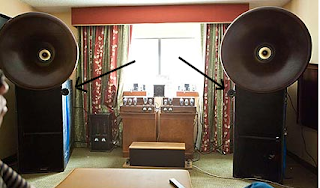I guess since I have the metal lathe and the Lowthers up and running, this project has shifted to me, yet I want to be clear the original concept is JJ's. I hinted to the progress in the Emancipation Day entry, and the Brown Truck brought a brown box with the last needed part some 4 X 0.7 mm threaded studs.
I didn't do them exactly to JJ's drawigns trying to keep it as close as possible to a typical doorknob plug. I installed them and put on some tunes as I wired them up. With them in place and not wired the highs were severely truncated but they quickly came back when I connected the tweeter through a 1 mic series cap. I only had enough time to get through 1 album side and I definitely need to play with phasing and crossover frequency but things are looking good!
As a proof of concept, there is a lot of promise and the second run through gave us a lot direction for the MK III variation. The first experiment happened with the use of a single drywall screw last May in Texas at the LSAF and quickly taught us that the physical distance between the voice coils need to be set to the crossover frequency. We also have a few other tricks to try out on the next revision so stay tuned to this work in progress.
Tuesday, April 19, 2011
Subscribe to:
Post Comments (Atom)
Blog Archive
-
▼
2011
(119)
-
▼
April
(15)
- Artemis Labs PH-1
- Guitar Eye Candy
- Munich High End 2011 Preview..
- I tasted my first Black Man today,
- Avoiding tornadoes and choosing a winner....
- Lowther Phase Plug Tweeters Pt. III
- Emancipation Day.
- Record Store Day....
- From the Stash.. and Free Stuff!
- Hamfest 2011...
- friends don't snipe friends...
- Western Electric Boxes
- More crates moving....
- the magic number
- Making Noodles.
-
▼
April
(15)












If you put the tweeter flush with the cone at the voice coil joint, it works better as you don't get the reflection off the cone delayed in time from the primary radiation of the tweeter. Also, typically you need the tweeter behind the lower frequency driver to get good group delay (time alignment). Looks cool though.
ReplyDeletehey JS....
ReplyDeletefirst, yeah.... I agree... but you have to step back and look at the application....
years ago we established that a phase plug larger than this one sounded and measured better in the midrange on the big LC horns.... so we know the reflections must not be as much of an issue as they appeaar....
second, we cannot drill out that pole piece... you should see the magnetic models of it.... so this alignment, while not perfect, is much better than being three feet away on the outside of the horn....
third, because it is to mate up to the lowther front horns, we need something with better than 105dB... this is the smallest great sounding tweet we have found...
I hope this helps clear up some of the reasoning....
Peace,
Me